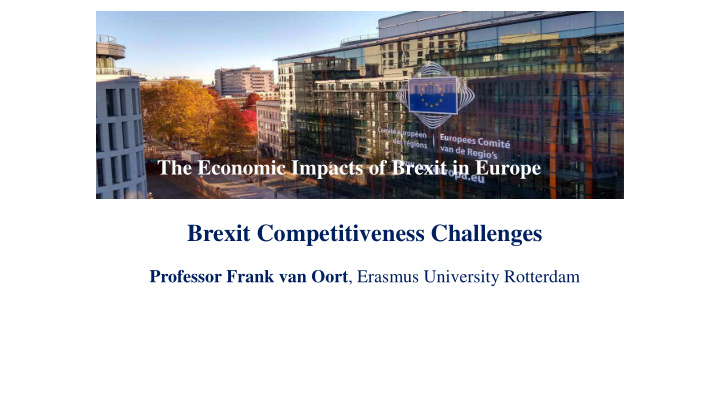



The Economic Impacts of Brexit in Europe Brexit Competitiveness Challenges Professor Frank van Oort , Erasmus University Rotterdam
The Implications of Brexit for UK and EU Regional Competitiveness Mark Thissen, Frank van Oort, Philip McCann & Raquel Ortega-Argiles
How does Brexit impact on competitiveness of (firms in) regions? 3
We distinguish Brexit-related: o Direct cost/price effect of tariffs o Indirect global value chain effects o Spatial competition effects 4
We decompose direct cost/price effects into: o Sector/region specific sensitivities of firms to WTO tariffs and non-tariff barriers (elasticities, scenario independent) o Policy- sensitive scenario’s (“hard Brexit ”, Dhingra et al. 2017)
Example of indirect Brexit-related effects Illustrative example of the Brexit-related impact on the price of beer in the United Kingdom: 1. A tariff is imposed on British steel 2. The German company that uses British steel to produce beer cans has to pay more – their production costs increase 3. The more expensive German cans are bought by a brewery in Belgium – their beer becomes more expensive 4. The beer from Belgium is exported to the United Kingdom. A Restaurant tariff is imposed on the beer imported into the UK – the price of the beer increases even further. The effect of the Brexit on production costs is larger as more components (raw materials, intermediate products, services) along the value chain of the production process cross the border between the United Kingdom and the European Union. 6
Value chain effects
What are spatial competition effects? • Changes in the competitiveness of sectors and regions depend not only on Brexit-related cost increases for companies in UK or EU regions, but also on those for their competitors. • The Brexit-related effect on the competitiveness of companies in different regions is therefore determined as the change in costs compared to the cost changes for their competitors. • This depends on: • the extent to which EU companies depend on UK products and services for their production, compared to their competitors; • where products and services of EU companies are sold and whether their competitors are located in the United Kingdom; • A Brexit will increases the price of EU products and services sold in the United Kingdom, while the price of those by UK competitors remains the same. • whether EU companies compete with UK companies in markets elsewhere in Europe. • A Brexit increases the price of UK products and services sold in the EU, while the price of those by their EU competitors remains the same. 8
Illustration of how competitiveness is measured The map shows an illustrative example of the markets of: Rotterdam London Vienna London and Rotterdam have the largest overlap in sales market. Competition between companies in London and those in Rotterdam is therefore larger than between those in London and those in Vienna For this research, we used the actual data on trade between all regions and the rest of the world. 9
Total production cost increase in hard-Brexit The average change in regional scenario in EU regions (direct effect of tariffs competitiveness due to Brexit and indirect effect of value chains) Comparable to spatial exposure pattern
The average change in international competitiveness due to Brexit Larger Larger, diversified urban regions loose less competitiveness 11
Competitiveness in detail in the UK
Competitiveness in detail in the UK
Competitiveness in detail in the UK
Competitiveness in detail in the UK
Competitiveness in detail in the UK
Findings: • The loss of competitiveness by international competing firms is twice as high in the UK than in the Netherlands (the second-largest Brexit-affected economy in the EU). • Effects of Brexit at national level conceal the diversity and heterogeneity of impacts by region and sector. • Brexit relatively strengthens the stronger and larger regional UK economies at the expense of the weaker regions. • The competitiveness of the food industry strengthens in the UK regions, weakens in the EU. • The competitiveness of the financial services and the automotive industry weakens in the UK, strengthens in the EU. • Sectors like the car industry (e.g. also electronics, machinery) will be hit by Brexit 17 independent of specific trade barriers due to large value chains.
Thank you for your attention
Recommend
More recommend